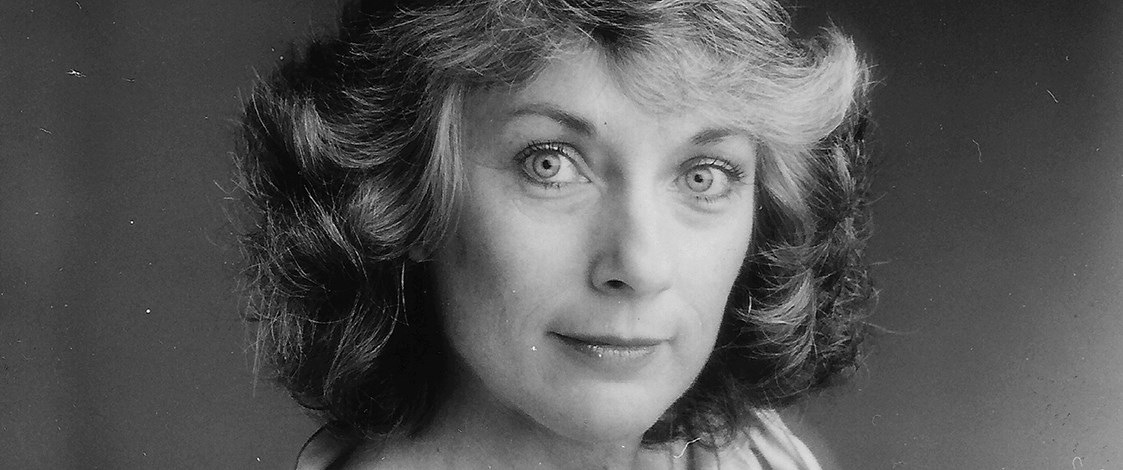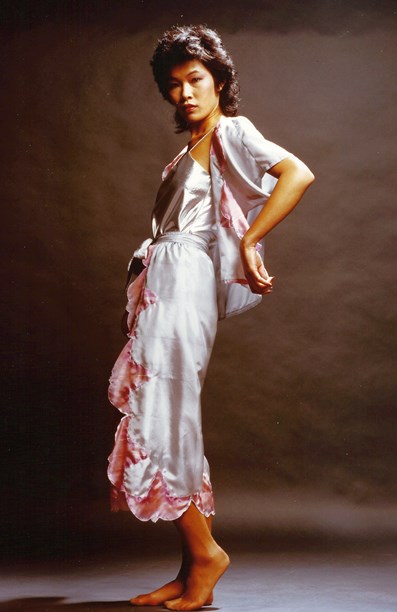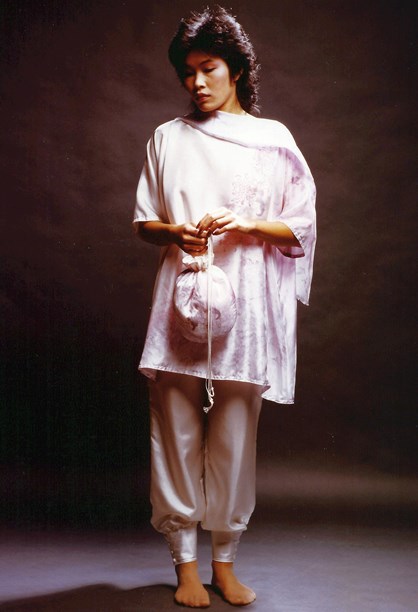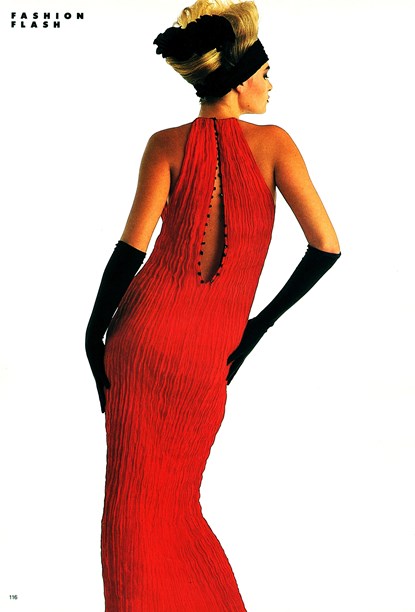Stories
Louisa Simons
1944-

For Louisa Simons, the wearable art story started in the late 1960s in her home town Dunedin. She had been introduced to batik while living in Sydney and, on her return, began experimenting with various forms of textile decoration. She recalls the garage beneath her home being filled with buckets of household dye, pots of wax, lengths of Thai silk and cotton gauze, and scrunched-up cloth, the "tie-dye of the 60s".
Eventually, Louisa became proficient in almost every facet of surface decoration in fibre - dyeing, painting, applique, beading, embroidery and traditional Japanese Shibori techniques as used in kimono dyeing. Silk was her preferred medium although she occasionally used other fabrics such as cotton and canvas.

Thunderbird Sunrise by Louisa Simons. The Itajime Shibori thunderbirds which outline the hem of the hand-dyed silk jacket and wrap pants are edged with silver lurex embroidery. A matching silver lurex camisole completes the outfit. 1980. Modelled by Geeling Ng. Image © Louisa Simons.
Over the next 20 years, she translated her fabrics into wearable works of art. Not to be confused with the spectacular show-stoppers in the New Zealand-based international design competition WOW (World of Wearable Art), Louisa’s garments were designed to be worn in everyday (or evening) situations.
Working as a one-woman band, she designed and created the fabrics, designed, made and marketed the clothes and sometimes modelled them for clients. In the 1980s, she operated from a studio workroom in her Parnell (Auckland) home. The fashion store Dischi carried samples of her designs, from which orders were taken and garments made to size. Pants and tops were complemented by dyed-to-match head-scarves and bags, and silk lingerie by matching kimonos.

Louisa Simons Chrysanthemum ensemble comprising a tunic, cuffed pants, scarf and drawstring bag in hand-painted silk. 1980. Modelled by Geeling Ng. Image © Louisa Simons.
It was Louisa’s dresses, however, that evoked the most eloquent response, particularly from the media. In the Sunday national newspaper New Zealand Times (November 1984), journalist Yvonne Chunn described the dresses thus: "In crepe de chine, fine Chinese silks, chiffon, georgette, they are light as the butterfly’s wings exquisitely printed on a skirt. Colours are sometimes two or three-toned, sometimes multi-hued. Hydrangeas, irises, a tiny beetle here, a moth there; gold thread may outline an insect’s wing or minute beads cluster in the heart of a flower. Necklines sweep low, fall off a shoulder with grace, sit smoothly smocked, a tiny grey pearl in each smock thread ... Such languid lovely garments require infinite patience and skill to create."
Women’s magazines such as Thursday (1970s), the New Zealand Woman’s Weeklyand Fashion Quarterly (1980s) were equally fulsome in their praise.
At the same time she was producing her fashion label, Louisa taught batik and dye-craft at the Whitecliffe College of Art & Design in Parnell. The course covered silk painting and all aspects of putting coloured decoration with instant dyes and pigment onto cloth.
Constantly on the lookout for new dimensions in which to express herself artistically, Louisa came back from a trip to London in 1986, excited by a Fortuny fashion exhibition she attended at Liberty’s. Intrigued by the famous Spanish textile and dress designer’s unique form of pleating, which rippled over the body in waves, she determined to fathom out how to create something similar. It took her two months experimentation. For each dress, she used approximately 10 metres of silk, and the pleating, painstakingly done by hand, was permanent. She used to get cross, she says, when people complimented her on her 'crystal pleating'. "Crystal pleating was produced on a machine in a factory and the fabric was usually polyester."
Although the pleating was Fortuny-inspired, the designs of the garments were Louisa’s own – columnar dresses, elongated tunics over long skirts, tiered skirts with cropped tops, ruched bustiers, head wraps and scarves. No two pieces were the same, intricately beaded neck-pieces, Nefertiti-style collars and Pierrot ruffles often providing the finishing touch.

Louisa Simons hand-dyed silk dress featuring Fortuny-style hand-pleating. The drawstring neck opens to a deep back slash edged with onyx beads. Designed for Fashion Quarterly fashion spread, Winter 1987. Image © Fashion Quarterly.
Saks, a Newmarket store specialising in top-of-the-line European men’s and women’s fashion labels, gave Louisa an 'open order' for her pleated pieces and presented them in a major fashion show at the recently opened Regent Hotel. "The high retail prices made it look as though I was making a fortune," she says "but the process was crazily labour-intensive so I wasn’t."
Louisa kept her pleating process secret. She had spent too much time mastering the technique to have it copied. Thirty years later, she’s happy to talk about it and admits to being the 'local girl' referred to by fellow fabric artist and wearable art exponent Susan Holmes in the 2016 publication Susan Holmes: Fabric Artist. Discussing her own experiments with what she termed 'crinkle silk', Susan told author Cerys Dallaway-Davidson: "I became aware in the 1980s that a local girl ... had been imitating the pleats of Fortuny. Using the material damp in a bath she got on her knees in front of the bath and pleated tiny little pleats in this silk." To which Louisa adds: "There was also chemical preparation of the hand-dyed silk involved and microwave treatment to set the twisted, pleated hanks of fabric."
Towards the end of the 1980s, Louisa decided to exit the fashion business. "It was off the body and onto the wall, so to speak. A Wellington gallery asked me to provide wall pieces, worked in Japanese dyeing techniques, to accompany an exhibition of tea ceremony ceramics by a Japanese master. The outcome was a generous grant from the Arts Council and Japan Foundation to study and work with traditional dyers in Japan. I never made any more garments after that, other than commissions."
Louisa Simons’ career as a fabric artist, educator and painter continued for another decade. She travelled extensively in Europe teaching, exhibiting, attending and holding workshops in art and design. Since 2000, she has lived in Australia. She no longer exhibits, describing her art practice today as for her own pleasure.
Text by Cecilie Geary. Banner image © Louisa Simons.
Last published January 2016.